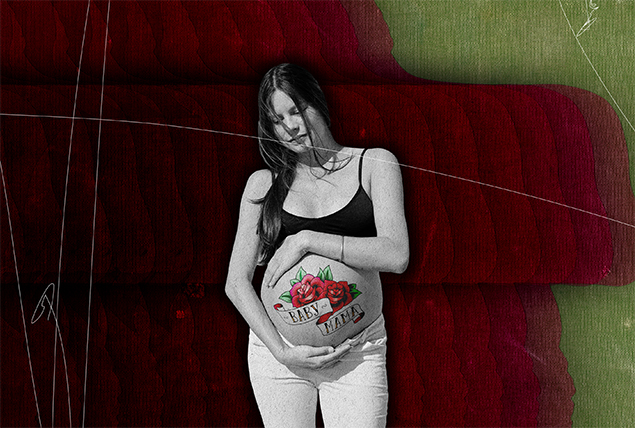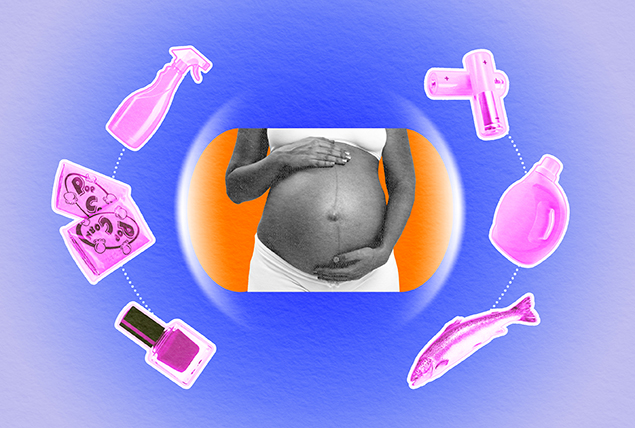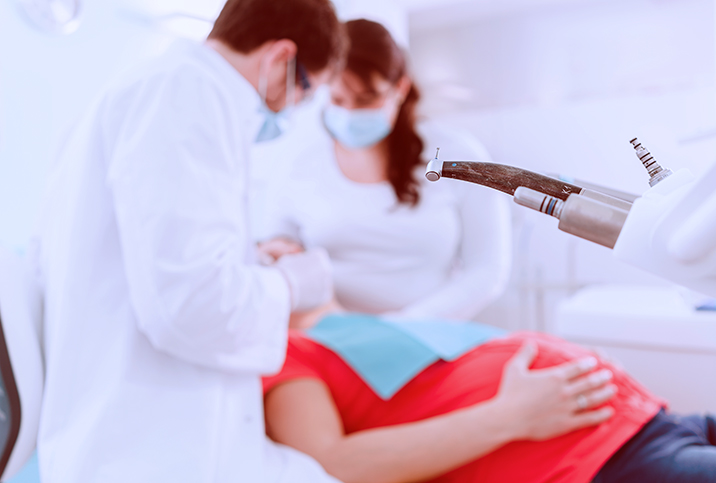Can I Bleach My Hair While Pregnant?

Key Points
- A new haircut or color can instantly boost your self-esteem, but certain chemicals in dyes and bleaches may be toxic.
- Most experts think it's safe to use hair dye or bleach during pregnancy, but some advise against it.
- Taking some precautions, such as waiting until the second or third trimester, may help potentially reduce risks.
Many pregnant people experience a prenatal glow-up with radiant skin and shiny hair, but feeling your best when your body is rapidly changing can still be difficult. A new 'do could boost your self-esteem, but is it safe?
We spoke with experts to determine if dyeing hair when pregnant is dangerous or if that's just one of the seemingly countless pregnancy myths.
Can you color your hair while pregnant?
Most experts say it's safe to use hair dye while pregnant, as these products aren't toxic to developing babies, according to the American College of Obstetricians and Gynecologists (ACOG).
Some healthcare experts disagree and maintain that it depends on the dye. Taking certain precautions can minimize potential risks if you color or bleach your hair while pregnant.
What kinds of chemicals are in hair dye?
Temporary, semi-permanent and permanent hair dyes work differently and contain distinct types and quantities of chemicals, such as the following, according to the American Cancer Society (ACS):
- Temporary. These dyes coat the hair shaft with color and last one to two washes.
- Semi-permanent. Semi-permanent products, designed to last five to 10 washes, penetrate the hair shaft but don't permanently alter its chemical composition.
- Permanent. Permanent products penetrate the hair shaft and change its chemical makeup. These dyes last until the hair is cut or grows out.
Temporary dyes contain the fewest chemicals, while permanent shades—especially dark colors—have the most, per the ACS.
The chemicals in semi-permanent and permanent dyes may include phenols, hydrogen peroxide, ammonia and aromatic amines such as paraphenylenediamine (PPD), derived from coal tar.
Ammonia raises the hair's pH level to facilitate the color change; peroxide strips the hair's natural pigment; and PPD applies the new color.
Does the body absorb the chemicals used in hair dye?
No reliable evidence suggests how many chemicals from hair dye enter the bloodstream, said Iris Dori, M.D., the medical director of the Center for Women's Health at Northwell Staten Island University Hospital in New York City.
Most experts believe there is minimal, if any, absorption, which may occur through the scalp, hair follicles or inhalation of fumes, said Monte Swarup, M.D., an OB-GYN and the founder of HPV HUB, in Chandler, Arizona.
People with conditions such as psoriasis or eczema are more likely to absorb chemicals from hair dye through broken skin.
During pregnancy
It's unlikely dyeing or bleaching hair when pregnant will adversely impact a parent or their baby, according to Swarup and Dori.
Some limited evidence suggests exposure to high amounts of PPD could potentially disrupt fetal development, said Meleen Chuang, M.D., a clinical associate professor in the Department of Obstetrics and Gynecology at Family Health Centers at NYU Langone Health in New York City.
The risk of pregnancy complications is thought to be highest in the first trimester.
Prolonged exposure to an exceedingly high amount of certain chemicals in hair dye may be hazardous, potentially contributing to complications such as bladder and breast cancer, non-Hodgkin's lymphoma and leukemia, per the ACS.
People who produce or work with dyes are most at risk, according to the United Kingdom's National Health Service (NHS).
Expectant mothers may be more vulnerable due to the immense changes that occur in the body during pregnancy, a 2022 study suggested.
While breastfeeding
Even if some chemicals from hair dye or bleach are absorbed by the body, they're not likely to infiltrate breast milk, Chuang said.
The American Academy of Pediatrics (AAP) suggests it is safe for breastfeeding people to dye their hair.
Recommended
- Tips for a Better Pregnancy: Some pregnancy symptoms, such as morning sickness and swollen ankles, are unavoidable, but taking certain steps can help to make the next nine months more bearable while protecting your and your baby's health.
- Avoid These Workouts During Pregnancy: Staying physically active is key to a healthy pregnancy, but some exercises are off-limits.
- Is Your Skin Peeling During Pregnancy?: Most, if not all, pregnant people experience skin changes. Stretch marks are the most common, but you could be prone to peeling, itchiness and even eczema stemming from hormonal changes.
When is it safe to color your hair while pregnant?
Experts don't know for sure if there's any time during a pregnancy when dyeing hair is unsafe, Dori said.
Out of an abundance of caution, some providers advise waiting until the second trimester, after the most significant organ development has occurred.
Can I get highlights while pregnant?
Hairstyles such as balayage, highlights and lowlights require less product, so while they contain the same chemicals as other permanent hair dyes, they may be slightly safer, Dori said.
Highlights are safe during pregnancy according to the ACOG, but again, Chuang said she advises women to wait to dye, bleach or highlight their hair until the second trimester at the soonest.
What are the risks of bleaching your hair while pregnant?
Although bleach contains many of the same chemicals as permanent hair color, most experts believe it's safe to use while pregnant, according to Swarup.
Others advise against bleaching your hair during pregnancy, including Chuang and Ila Dayananda, M.D., an OB-GYN and the chief medical officer at Oula Health in New York City.
Even if bleach is nontoxic to the fetus, it is a caustic chemical, and prolonged exposure could cause respiratory issues, Dayananda said. Inhaling the fumes may lead to a nosebleed, nausea, headache or fainting.
It could trigger an attack in people with asthma.
What type of hair dye is safe for coloring when you're pregnant?
Most hair dyes contain the same ingredients, but the specifics vary from one product to another, and there are ways to color your hair without chemicals. Generally, choosing a plant-based product free of PPD, ammonia and peroxide is the safest bet.
Semi-permanent coloring
Temporary and semi-permanent hair dyes don't require ammonia or peroxide, making them a safer alternative to permanent hair color. Some are also PPD-free.
Natural hair dye
Henna and pure vegetable dyes are free of ammonia, peroxide and other potentially harmful chemicals found in traditional hair dyes. Henna and vegetable dyes also tend to be gentler on the hair and scalp, which could reduce the risk of potential skin irritation or allergic reactions, Chuang and Dayananda said.
Note that not all "natural" dyes are created equal. Some of these dyes may contain PPD, so check the label to be sure.
What kinds of precautions should I take when dyeing my hair at home?
For your health and hair, it's best to leave bleaching and dyeing to the professionals, especially if you're seeking a permanent change. If you decide to do it yourself, take the following precautions.
Bleach in a well-ventilated area
Minimize fume inhalation and your risk of adverse effects by opening windows or using an exhaust fan to ventilate your home salon.
Perform a patch test
Skin rashes are common during pregnancy, and about one-third of expecting moms experience worsening allergy symptoms in the prenatal period, according to the Allergy and Asthma Network.
Certain ingredients in hair dye, including PPD, may cause allergic reactions or irritation. Do a patch test 24 hours before coloring your hair to ensure your skin doesn't react.
Wear the gloves
Gloves minimize skin exposure to dye and the risk of unpleasant skin reactions. Wear the gloves included in your at-home hair coloring kit.
Follow the directions
Package directions aren't just there to help you get a decent dye job but for your safety. Only leave the dye on your hair as recommended. Overprocessing your hair could increase potential skin absorption and irritation.
Rinse your hair and scalp thoroughly until the water runs clear.
What are some scalp and aftercare tips?
Hair color and bleach can be hard on the scalp. Properly caring for hair and skin after using hair dye can help reduce any lingering irritation or dryness and promote healthy new hair growth.
Christi Morgan is a licensed master colorist and the owner of Bask Hair and Beauty Bar in Collierville, Tennessee. She recommends using a scalp scrub and deep conditioning treatments. Hair and scalp masks with hydrating and fortifying ingredients, such as vitamin E, shea, almond, jojoba and coconut oil, are good options.
"This will not only create a relaxing routine but also lessen the chances of the hair becoming brittle and causing breakage," Morgan said.
How often can you color your hair while you're pregnant?
It's best to avoid dyeing or bleaching more than once every three months, Morgan said. This can limit chemical exposure and allow your scalp and hair to recover.
Your hair and skin can change significantly during pregnancy, so your stylist should reassess your hair.
"They're basically a new client every time they walk into the salon," Morgan said of her pregnant clients.
How can you help your hair dye last longer during your pregnancy?
How long your new hue lasts will depend primarily on the type of product you use, but the following tips can help it last longer:
- Avoid shampooing for 48 hours after dyeing or bleaching.
- Use a high-quality, color-safe shampoo.
- Keep hair out of the sun.
- Rinse hair with cold water, as heat fades hair faster.
- Apply heat protectant.
The bottom line
Dyeing or bleaching hair while pregnant is generally considered safe, since few, if any, chemicals are likely to enter the bloodstream. To err on the side of caution, use ammonia-, PPD- and peroxide-free products—ideally products made from henna or vegetables.
When weighing the potential risks, don't forget your well-being, Dori said. If the thought of not coloring your hair for nine months is distressing, it may be better to go ahead and do it.
Talk to your doctor if you have any concerns about your safety or your baby's.


















